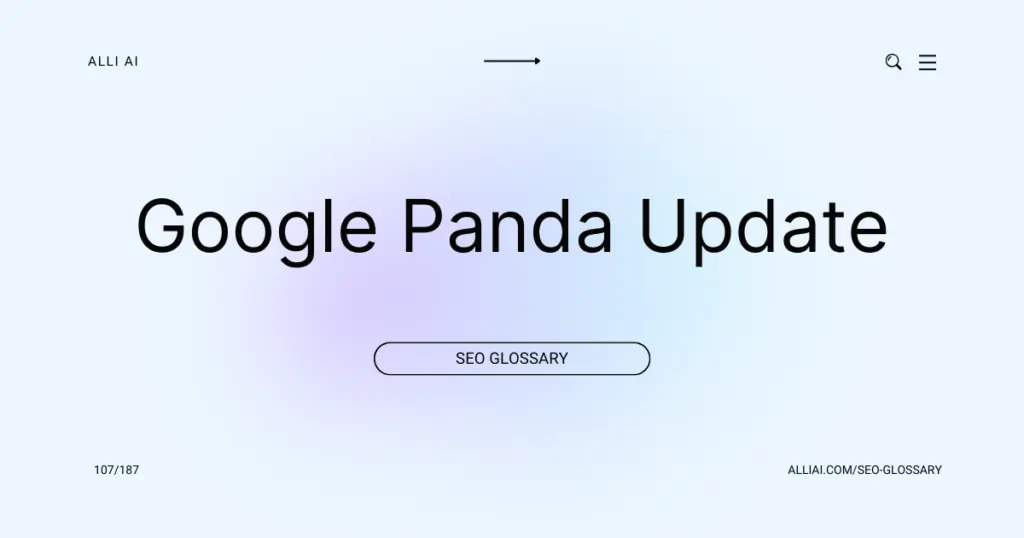What Does Google Panda Update Mean?
The Google Panda Update is a change made by Google to its search engine ranking algorithm, introduced in 2011. Its main purpose is to lower the rank of low-quality sites that provide poor user experiences and raise the ranking of high-quality sites with original content and information such as research, in-depth reports, thoughtful analysis, etc. This update aims to ensure that users get the most relevant and highest quality results for their search queries.
Where Does Google Panda Update Fit Into The Broader SEO Landscape?
Google Panda is a major update to Google’s search algorithm that was first released in February 2011. It is designed to lower the rank of “low-quality sites” or “thin sites,” and raise the ranking of higher-quality sites that provide valuable and unique content to users. The Panda update primarily targets sites with content that is shallow or lacks substance, has excessive ads, or duplicates content from other sources. It encourages website owners and content creators to focus on quality content that is useful and relevant to readers. This update has been integrated into Google’s core algorithm and continues to impact SEO strategies, emphasizing the importance of high-quality content in achieving and maintaining good search engine rankings.
Real Life Analogies or Metaphors to Explain Google Panda Update
Imagine you’re at a book club where everyone is eager to present their favorite book. But rather than bringing novels written with care and rich in content, some attendees start showing flashy book covers with poorly written content inside. This frustrates everyone who expected high-quality readings.
Google Panda is like the book club leader who decides to enforce a new rule: only high-quality books are appreciated and recommended by the club, reducing the visibility of the books that look good on the outside but lack substance. This way, the club ensures that members enjoy genuinely engaging and worthwhile books, improving the overall experience.
How the Google Panda Update Functions or is Implemented?
Google Panda is an algorithm update aimed at reducing the prevalence of low-quality content in search results and improving the quality of search engine rankings. It functions primarily by assigning a quality score to web pages based on various factors. This score impacts a site’s ranking in Google’s search results.
1. Content Evaluation: The Panda algorithm assesses content for uniqueness, relevance, and quality. It downgrades pages with duplicate, thin, or plagiarized content that provide little value to users.
2. User Engagement Metrics: Panda considers user signals, such as time on site, bounce rate, and page views per visit, to gauge content quality and engagement. If users typically leave a site quickly, it might indicate poor quality.
3. Website Trustworthiness: The algorithm evaluates trust signals, including secure connections (HTTPS), accurate and factual information, and the presence of contact information on a site as indicators of a site’s credibility.
4. Site Architecture: Well-organized sites that enable easy navigation and are structured logically tend to be favored. Poor site architecture, on the other hand, can affect the crawling and indexing of pages.
5. Content Hierarchy: Panda favors websites with a clear hierarchy and textual content formatted with headers that make it easier for Google to understand and index.
6. Ads to Content Ratio: Pages overwhelmed with ads rather than informative content are likely to be penalized under Panda.
7. Update Rollout: Originally, Panda functioned via periodic updates where sites could be penalized or rewarded in batches as the algorithm updated. It has since become more integrated into the main ranking algorithm, updating continuously.
8. Recovery Process: Websites affected by Panda need to make significant quality improvements and wait for these changes to be recognized in subsequent algorithm updates or refreshes.
9. Panda and Machine Learning: Over time, Google has incorporated machine learning into Panda, which helps in making finer distinctions in content quality.
Impact Google Panda Update has on SEO
The Google Panda Update targets websites with low-quality content, leading to lower rankings for such sites in Google’s search results. Websites with high-quality, original content are more likely to see improved rankings. This update prioritizes user experience by reducing the visibility of thin, duplicated, or spammy content, encouraging a more satisfying and trustworthy browsing experience for users. Panda penalizes keyword stuffing and encourages a natural writing style more focused on user engagement and content value. Overall, the update reinforces the need for websites to focus on content quality to maintain or improve their SEO performance.
SEO Best Practices For Google Panda Update
1. Assess Website Content Quality:
– Conduct a thorough review of all the content on your website.
– Identify and remove duplicate, overlapping, or redundant articles.
– Ensure that content is original and provides real value to users.
2. Improve User Experience:
– Analyze the website design and navigation to ensure it is user-friendly and accessible.
– Test and optimize website speed (use tools like Google PageSpeed Insights).
– Ensure your website is responsive and works well on all devices, especially mobiles.
3. Increase Content Authority:
– Identify key topics that are central to your niche.
– Develop comprehensive, in-depth content that addresses those topics thoroughly.
– Utilize credible sources and data to back up claims and add credibility.
4. Eliminate Shallow or Low-Quality Content:
– Review short, less informative pages and either enhance them with more detailed information or consider removing them.
– Merge shorter content that addresses similar topics into comprehensive single articles.
5. Use Structured Data:
– Implement schema markup to help search engines understand and index your content better.
– Use relevant schemas like Article, Product, Organization, etc.
6. Optimize On-Page SEO Elements:
– Ensure that title tags, meta descriptions, and headers (H1, H2, etc.) include relevant keywords without stuffing.
– Check for and fix broken links and correct any poor redirections.
7. Engage with Social Media:
– Increase content visibility and engagement by sharing on social media platforms.
– Encourage user interaction to boost social signals, which can indirectly affect rankings.
8. Update Content Regularly:
– Refresh old content with current information and new data.
– Regularly add new content to keep the site dynamic and informative.
9. Monitor User Feedback:
– Pay attention to comments and reviews from users for insights into their needs and the user experience provided.
– Adjust content based on constructive user feedback to better serve the target audience.
10. Perform Regular Audits:
– Regularly use SEO tools to conduct audits and check for issues like keyword cannibalization, poor page speed, and broken links.
– Analyze performance using Google Analytics to understand which content works and what doesn’t.
Common Mistakes To Avoid
1. Low-Quality Content: Google Panda targets low-quality, thin content. Avoid creating pages with little or no original content, or content copied from other sources.
2. Keyword Stuffing: Overusing keywords can make content unreadable and be flagged as spammy by Panda. Use keywords naturally and sparingly.
3. Poor User Experience: Websites that are hard to navigate, have excessive ads, or load slowly can be penalized. Ensure a clean, user-friendly design and good site speed.
4. Content Farming: Mass-producing content or using multiple authors who write on a dizzying array of topics can dilute quality. Focus on niche expertise and depth.
5. Duplicate Content: Having multiple pages with substantially similar content can be seen as manipulative. Use canonical tags or improve content to differentiate pages.
6. Irrelevant Content: Ensure all content is relevant to your audience and matches your site’s primary topics. Straying too far from your main subjects can dilute overall site quality.
7. Unnatural Backlinks: A high volume of poor-quality backlinks can signal to Panda that your site might be spam. Focus on earning high-quality links naturally.
8. Over-Optimization: Websites overly optimized for SEO rather than user engagement can be penalized. Balance SEO practices with genuine value for users.
9. Ignoring Analytics: Not monitoring site analytics to understand content performance can lead to missed opportunities for improvement. Regularly review bounce rates, time on site, and user engagement.
10. Infrequent Updates: Infrequently updated sites can be seen as less valuable. Keep content fresh and relevant.
By focusing on high-quality, user-centric content and avoiding these pitfalls, you can better align with the goals of Google Panda and improve your site’s standing in search rankings.






